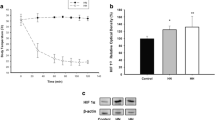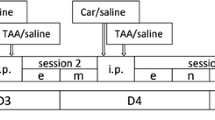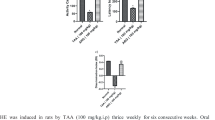Abstract
Previous studies have demonstrated protective effects of mild hypothermia following acetaminophen (APAP)-induced acute liver failure (ALF). However, effects of this treatment in ALF due to other toxins have not yet been fully investigated. In the present study, the effects of mild hypothermia in relation to liver pathology, hepatic and cerebral glutathione, plasma ammonia concentrations, progression of encephalopathy, cerebral edema, and plasma proinflammatory cytokines were assessed in mice with ALF resulting from azoxymethane (AOM) hepatotoxicity, a well characterized model of toxic liver injury. Male C57BL/6 mice were treated with AOM (100 µg/g; i.p.) or saline and sacrificed at coma stages of encephalopathy in parallel with AOM mice maintained mildly hypothermic (35°C). AOM treatment led to hepatic damage, significant increase in plasma transaminase activity, decreased hepatic glutathione levels, and brain GSH/GSSG ratios as well as selective increases in expression of plasma proinflammatory cytokines. Mild hypothermia resulted in reduced hepatic damage, improvement in neurological function, normalization of glutathione levels, and selective attenuation in expression of circulating proinflammatory cytokines. These findings demonstrate that the beneficial effects of mild hypothermia in experimental AOM-induced ALF involve both antioxidant and anti-inflammatory mechanisms.



Similar content being viewed by others
Abbreviations
- ALF:
-
Acute liver failure
- AOM:
-
Azoxymethane
- APAP:
-
Acetaminophen
- BBB:
-
Blood-brain barrier
- IFN-γ:
-
Interferon-gamma
- IL:
-
Interleukin
- SIRS:
-
Systemic inflammatory response syndrome
- TNF-α:
-
Tumor necrosis factor-alpha
References
Andus T, Bauer J, Gerok W (1991) Effects of cytokines on the liver. Hepatology 13:364–375
Bélanger M, Coté J, Butterworth RF (2006) Neurobiological characterization of an azoxymethane mouse model of acute liver failure. Neurochem Int 48:434–440
Bémeur C, Desjardins P, Qu H, Butterworth RF (2008) N-acetylcysteine selectively modulates inflammatory cytokines in nonacetaminophen acute liver failure in mice. 13th International Symposium on Hepatic Encephalopathy and Nitrogen Metabolism, Padova. Liver Int 28:731, abstract
Bémeur C, Desjardins P, Butterworth RF (2010) N-Acetylcysteine attenuates cerebral complications of non-acetaminophen-induced acute liver failure in mice: antioxidant and anti-inflammatory mechanisms. Metab Brain Dis (In press)
Clemmesen JO, Larsen FS, Kondrup J, Hansen BA, Ott P (1999) Cerebral herniation in patients with acute liver failure is correlated with arterial ammonia concentration. Hepatology 29:648–653
de Vries HE, Blom-Roosemalen MC, van Oosten M, de Boer AG, van Berkel TJ, Breimer DD, Kuiper J (1996) The influence of cytokines on the integrity of the blood–brain barrier in vitro. J Neuroimmunol 64:37–43
Duchini A, Govindarajan S, Santucci M, Zampi G, Hofman FM (1996) Effects of tumor necrosis factor-alpha and interleukin-6 on fluid-phase permeability and ammonia diffusion in CNS-derived endothelial cells. J Investig Med 44:474–482
Ericsson A, Liu C, Hart RP, Sawchenko PE (1995) Type 1 interleukin-1 receptor in the rat brain: distribution, regulation, and relationship to sites of IL-1-induced cellular activation. J Comp Neurol 361:681–698
Jalan R, Williams R (2001) The inflammatory basis of intracranial hypertension in acute liver failure. J Hepatol 34:940–942
Jalan R, Pollok A, Shah SH, Madhavan K, Simpson KJ (2002) Liver derived proinflammatory cytokines may be important in producing intracranial hypertension in acute liver failure. J Hepatol 37:536–538
Jalan R, Olde Damink SW, Deutz NE, Hayes PC, Lee A (2004) Moderate hypothermia in patients with acute liver failure and uncontrolled intracranial hypertension. Gastroenterology 127:1338–1346
Jiang W, Desjardins P, Butterworth RF (2009) Direct evidence for central proinflammatory mechanisms in rats with experimental acute liver failure: protective effect of hypothermia. J Cereb Blood Flow Metab 29:944–952
Marmarou A, Poll W, Shulman K, Bhagavan H (1978) A simple gravimetric technique for measurement of cerebral edema. J Neurosurg 49:530–537
Matkowskyj KA, Marrero JA, Carroll RE, Danilkovich AV, Green RM, Benya RV (1999) Azoxymethane-induced fulminant hepatic failure in C57BL/6J mice: characterization of a new animal model. Am J Physiol 277:G455–G462
Mita A, Hashikura Y, Tagawa Y, Nakayama J, Kawakubo M, Miyagawa S (2005) Expression of Fas ligand by hepatic macrophages in patients with fulminant hepatic failure. Am J Gastroenterol 100:2551–2559
Nagaki M, Iwai H, Naiki T, Ohnishi H, Muto Y, Moriwaki H (2000) High levels of serum interleukin-10 and tumor necrosis factor-alpha are associated with fatality in fulminant hepatitis. J Infect Dis 182:1103–1108
Riordan SM, Williams R (2003) Mechanisms of hepatocyte injury, multiorgan failure, and prognostic criteria in acute liver failure. Semin Liver Dis 23:203–215
Rolando N, Wade J, Davalos M, Wendon J, Philpott-Howard J, Williams R (2000) The systemic inflammatory response syndrome in acute liver failure. Hepatology 32:734–739
Rose C, Michalak A, Pannunzio M, Chatauret N, Rambaldi A, Butterworth RF (2000) Mild hypothermia delays the onset of coma and prevents brain edema and extracellular brain glutamate accumulation in rats with acute liver failure. Hepatology 31:872–877
Schmidt LE, Larsen FS (2006) Prognostic implications of hyperlactatemia, multiple organ failure, and systemic inflammatory response syndrome in patients with acetaminophen-induced acute liver failure. Crit Care Med 34:337–343
Sekiyama KD, Yoshiba M, Thomson AW (1994) Circulating proinflammatory cytokines (IL-1 beta, TNF-alpha, and IL-6) and IL-1 receptor antagonist (IL-1Ra) in fulminant hepatic failure and acute hepatitis. Clin Exp Immunol 98:71–77
Simpson KJ (1999) Cytokines, for better or worse? Eur J Gastroenterol Hepatol 11:957–966
Tietze F (1969) Enzymic method for quantitative determination of nanogram amounts of total and oxidized glutathione: applications to mammalian blood and other tissues. Anal Biochem 27:502–522
Vaquero J, Butterworth RF (2007) Mild hypothermia for the treatment of acute liver failure—what are we waiting for? Nat Clin Pract Gastroenterol Hepatol 4:528–529
Vaquero J, Polson J, Chung C, Helenowski I, Schiodt FV, Reisch J, Lee WM, Blei AT (2003) Infection and the progression of hepatic encephalopathy in acute liver failure. Gastroenterology 125:755–764
Vaquero J, Rose C, Butterworth RF (2005) Keeping cool in acute liver failure: rationale for the use of mild hypothermia. J Hepatol 43:1067–1077
Vaquero J, Bélanger M, James L, Herrero R, Desjardins P, Côté J, Blei AT, Butterworth RF (2007) Mild hypothermia attenuates liver injury and improves survival in mice with acetaminophen toxicity. Gastroenterology 132:372–783
Yam LT, Li CY, Crosby WH (1971) Cytochemical identification of monocytes and granulocytes. Am J Clin Pathol 55:283–290
Yasumi Y, Takikawa Y, Endo R, Suzuki K (2007) Interleukin-17 as a new marker of severity of acute hepatic injury. Hepatol Res 37:248–254
Acknowledgments
This study was supported by a grant from the Canadian Institutes for Health Research. C.B. is a recipient of a fellowship from the Canadian Association for the Study of the Liver (CASL)/Astellas Pharma Canada.
Author information
Authors and Affiliations
Corresponding author
Rights and permissions
About this article
Cite this article
Bémeur, C., Desjardins, P. & Butterworth, R.F. Antioxidant and anti-inflammatory effects of mild hypothermia in the attenuation of liver injury due to azoxymethane toxicity in the mouse. Metab Brain Dis 25, 23–29 (2010). https://doi.org/10.1007/s11011-010-9186-x
Received:
Accepted:
Published:
Issue Date:
DOI: https://doi.org/10.1007/s11011-010-9186-x




